Riddles for 8 Year Olds with Answers
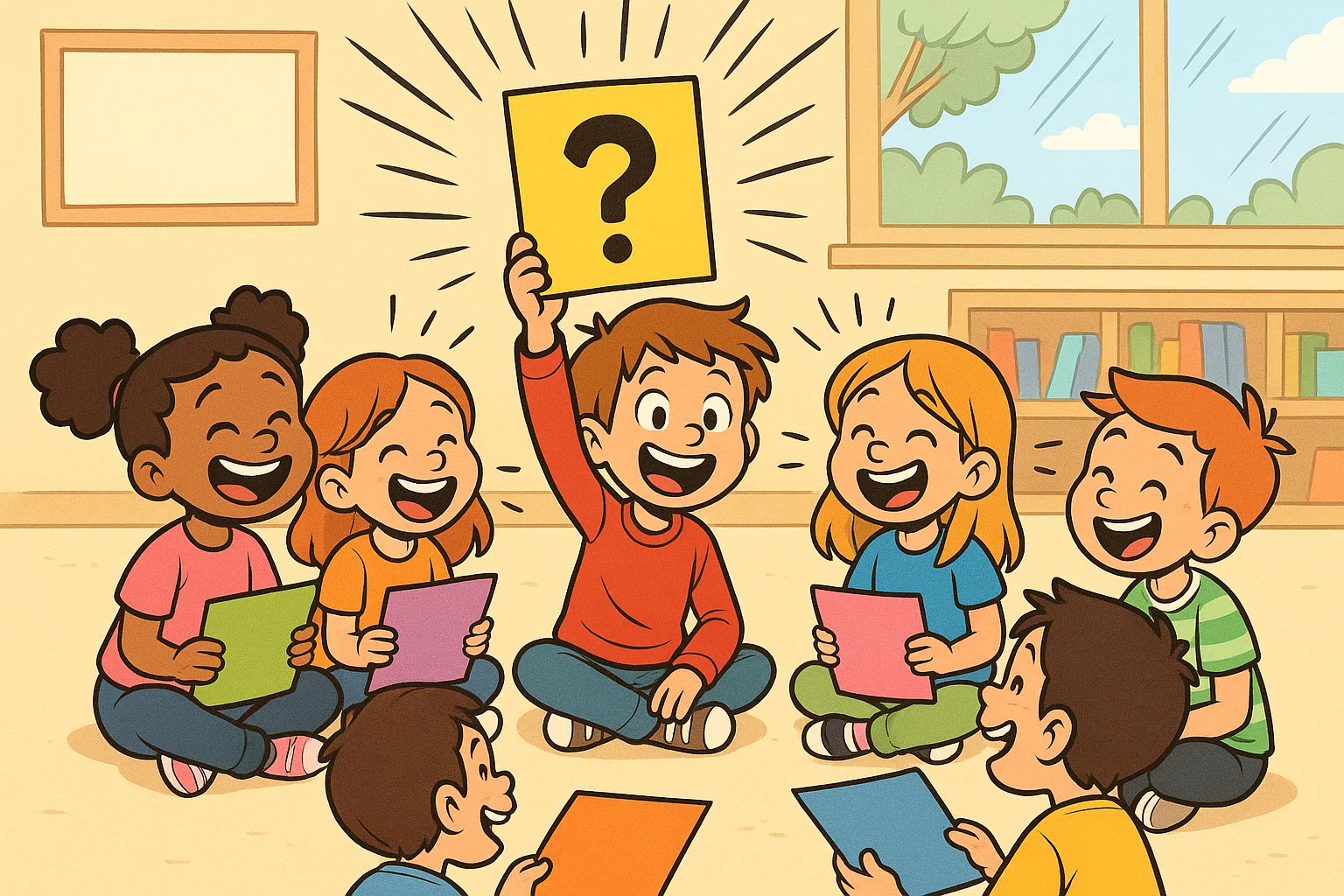
Around age eight, children begin shifting from concrete ideas to more abstract, logical thinking—making it the perfect time for riddles! Riddles spark creativity, boost problem-solving, and feel like play rather than work. The ones here are age-appropriate: challenging enough to engage but not frustrating, helping kids build confidence, sharpen memory, and enjoy bonding with family and friends.
Easy Riddles for 8 Year Olds
These easy riddles are perfect for getting started and building confidence. They provide a quick win, which can motivate children to tackle more difficult challenges. Solving riddles gives a child a real sense of accomplishment, proving to themselves that they can figure things out.
Funny easy riddles
Light-hearted riddles are a great way to start. They introduce an element of playfulness and humor, making the process of solving riddles even more enjoyable.
- I have a bed but never sleep, a mouth but never talk, and I can run but have no legs. What am I? (A river)
- I’m light as a feather, but even the strongest person can’t hold me for more than five minutes. What am I? (Your breath)
- What has an eye but cannot see? (A needle)
- What has a face and two hands but no arms or legs? (A clock)
- Why was the math book sad? (Because it had too many problems!)
Short easy riddles
Sometimes the best riddles for kids are short and to the point. These quick riddles are excellent for fast-paced games or for when you only have a minute or two. They require a child to think fast and apply what they know.
- What belongs to you, but other people use it more than you do? ( Your name)
- What is full of holes but still holds water? (A sponge)
- What has a head and a tail but no body? (A coin)
- I get wet while drying. What am I? (A towel)
- What can you catch but not throw? (A cold)
Classic riddles kids love
Some riddles have stood the test of time because they encourage kids to think in new ways and are often the first ones children learn to enjoy. They often play with common words in new and surprising ways.
- What has cities with no buildings, forests with no trees, and water with no fish? (A map)
- A man who was outside in the pouring rain without an umbrella or hat didn’t get a single hair on his head wet. Why not? (He was bald)
- What goes up but never comes down? (Your age)
- What has an ear but cannot hear? (Corn)
- What is always in front of you but can’t be seen? (The future)
Tricky Riddles for 8 Year Olds
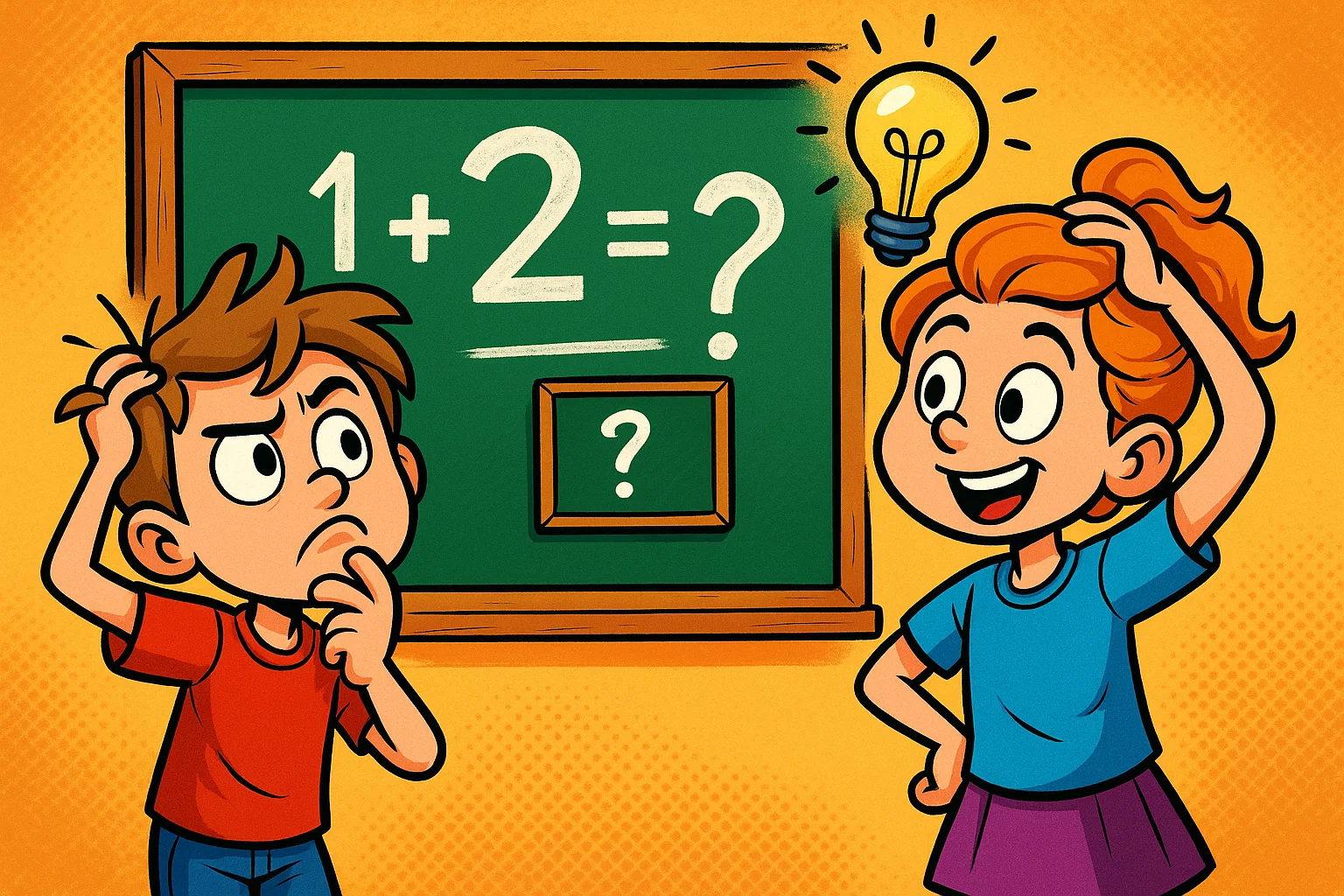
When a child has mastered the easy riddles, it’s time to introduce more challenging ones. These brain teasers for kids are designed to stretch their minds, encouraging them to think outside the box and consider multiple possibilities.
Brain teasers
These logical riddles require careful reasoning and attention to detail. They train a child to pay close attention to every word of the question, as a single detail can hold the key to the solution.
- I have cities, but no houses. I have mountains, but no trees. I have water, but no fish. What am I? (A map).
- The more you take, the more you leave behind. What are they? ( Footsteps).
- I am always hungry and will die if not fed, but if you water me, I’ll die. What am I? (Fire).
- A farmer has 17 sheep, and all but 9 die. How many are left? (Nine).
- I can run, but never walk. I have a mouth but never talk. I have a bed but never sleep. I have a head, but never weep. What am I? (A river).
Math
Math puzzles are a great way to make numbers fun. They challenge a child to apply their arithmetic and logical thinking in creative scenarios.
- I am an odd number. Take away one letter and I become even. What number am I? (Seven).
- A mother has four daughters, and each of her daughters has a brother. How many children does the mother have in total? (Five (four daughters and one son)).
- How can you add eight 8s to make 1,000? (888 + 88 + 8 + 8 + 8 = 1,000).
- If you’re running in a race and you pass the person in second place, what place are you in? (Second place).
- There is a one-story house where everything is yellow. The walls are yellow, the doors are yellow, and the furniture is yellow. What color are the stairs? (There are no stairs; it’s a one-story house).
Word
These riddles play with language, spelling, and double meanings. They are excellent for building vocabulary and an appreciation for the nuances of language.
- What has an end but no beginning, a home but no family, a head but no body? (A thread of yarn).
- What five-letter word becomes shorter when you add two letters to it? (Short).
- What has many teeth, but cannot bite? (A comb).
- What has a neck but no head, and wears a cap but has no eyes? (A bottle).
- What word is spelled wrong in every dictionary? (Wrong).
Funny Riddles for 8 Year Olds
Humor is a powerful tool for learning. These funny riddles for kids are perfect for keeping kids busy and entertained, whether on a road trip, during a family dinner, or simply on a rainy afternoon.
Silly riddles
These are meant to be silly and get a laugh. Their answers are often absurd, but in a way that makes perfect sense.
- What has four wheels and flies? (A garbage truck).
- What do you get if you cross a snowman with a vampire? (Frostbite).
- Why don’t eggs tell jokes? (They’d crack each other up!)
- What kind of tree can you hold in your hand? (A palm tree).
- What do you call a fake noodle? (An impasta).
Animal jokes
Animals are universally loved by kids of all ages. Combining them with riddles adds a fun, familiar twist.
- I am black and white and read all over. What am I? (A newspaper (a play on words: “read” vs. “red”)).
- What kind of lion never walks? (A dandelion).
- What do you call a fish with no eyes? (Fsh).
- What has a tongue but cannot talk? (A shoe).
- What do you call a bear with no teeth? (A gummy bear).
Food
Everyone loves food, making these riddles relatable and fun.
| Riddle | Answer |
| I have a head and a tail, but no body. What am I? | A head of lettuce |
| What has to be broken before you can eat it? | An egg |
| What vegetable is the most fun at a party? | A fun-gi (fungi) |
| What is a vampire’s favorite fruit? | A blood orange |
| What has a mouth but never eats? | A jar or bottle |
School Riddles for 8 Year Olds
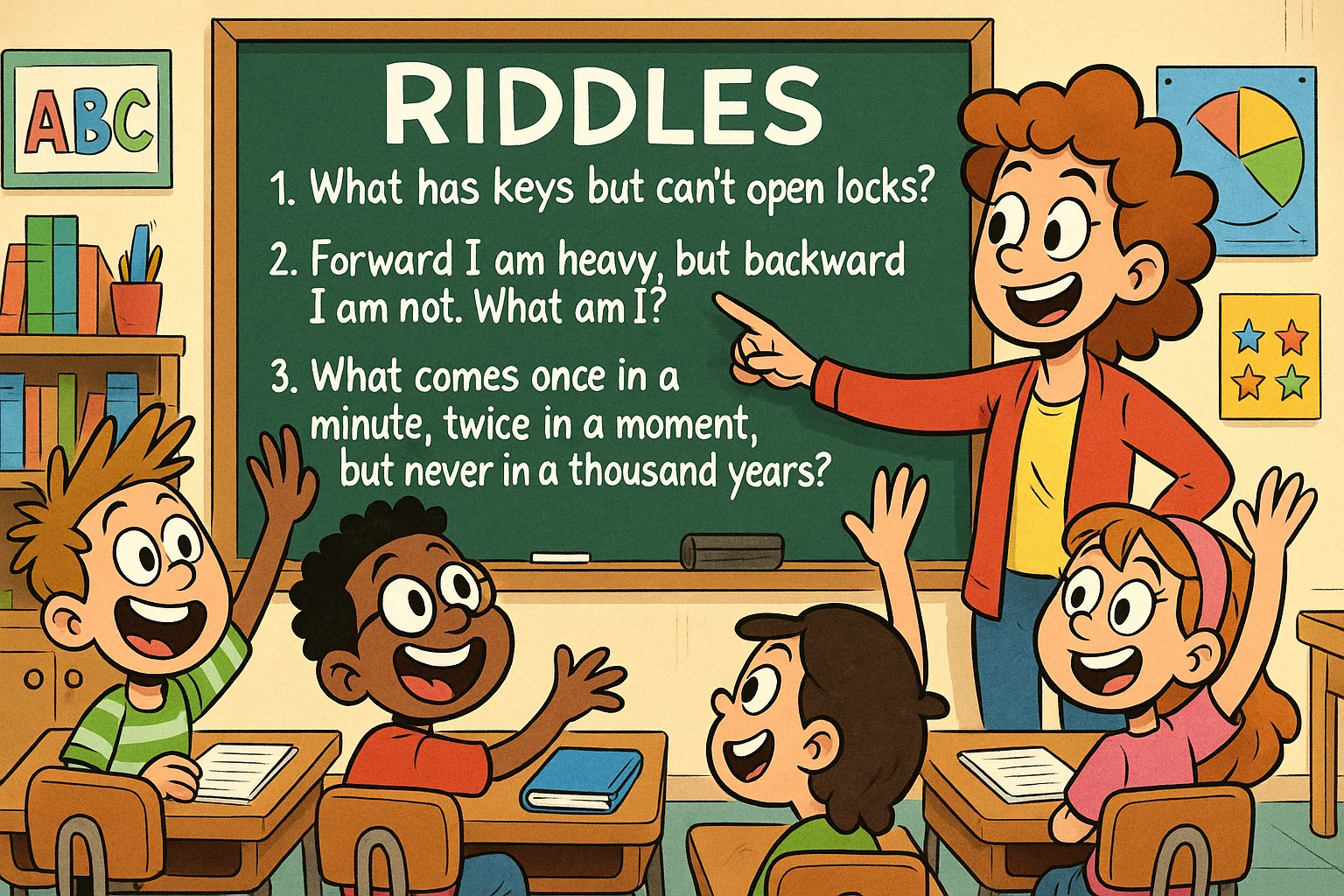
These riddles are a great way to link learning to fun. They can be used by teachers, parents, or for classroom games.
Back to school
These are perfect for icebreakers or classroom warm-ups.
- I have a spine but no bones, and I tell stories without a mouth. What am I? (A book).
- I have keys but no locks. I have a space but no room. You can enter, but you can’t go in. What am I? (A keyboard).
- What has an end and a beginning but is not a story? (The alphabet).
- What has a bottom at the top? (A pencil).
- What can you find in the middle of a math book? (The letter ‘h’).
Science
Riddles about the natural world can spark curiosity about science.
- I don’t have lungs, but I need air to live. I don’t have a mouth, but water kills me. What am I? ( Fire).
- What can fill a room but takes up no space? (Light).
- I have a face but no eyes, a head but no mouth, and you can see me in the sky. What am I? (The moon).
- I can be hot, cold, or warm, and I can be hard, or a gas, or even soft. What am I? (Water).
- I have a tail but no head, and I can travel to the stars. What am I? (A comet).
English and wordplay
These riddles help with vocabulary and thinking about the structure of language.
| Riddle | Answer |
| What has many words but never talks? | A dictionary |
| What two words, when combined, hold the most letters? | Post office |
| What is at the end of a rainbow? | The letter ‘W’ |
| I have an ear, but I can’t hear. What am I? | A word in the dictionary |
| What has a long neck and eats leaves from tall trees? | A giraffe (but also a word in the dictionary). |
Holiday and Seasonal Riddles
Adding a festive or seasonal theme to riddles is a great way to celebrate and keep learning and development fun during special times of the year.
Halloween
These are spooky but not too scary, perfect for a Halloween party or trick-or-treating.
- I wear a black cloak and have no bones, but I give you chills when you see my home. What am I? Answer: A ghost.
- I have a head and a tail, but no body. I live in a dark place and love to scare. What am I? Answer: A shadow.
- I have many eyes but cannot see. I love to be carved with a big, wide smile. What am I? Answer: A pumpkin.
- What do you call a witch’s garage? Answer: A broom closet.
- Why did the zombie go to the library? Answer: He wanted some brains!
Christmas
These festive riddles are a great way to get into the holiday spirit.
- What is a reindeer’s favorite game? Answer: Sleigh-ride.
- I’m tall when I’m young, and I get shorter as I grow older. You can find me on a dinner table, but you can also find me on a tree. What am I? Answer: A candle.
- I have a long beard and wear red, but I am not a person. I come down the chimney but am never dirty. What am I? Answer: Santa Claus’s suit.
- What do you call a snowman in July? Answer: A puddle.
- What do you get if you eat Christmas decorations? Answer: Tinsel-itis.
Summer
Perfect for summertime fun and outdoor adventures.
- I am always running, but I never get tired. I have a bank but no money. What am I? Answer: A river.
- I can be caught but not thrown. I love to be around when it’s hot. What am I? Answer: A sunbeam.
- What do you call a sun with no clothes on? Answer: A solar eclipse.
- I go up, but never down. I love the warmth and will go away when it’s cold. What am I? Answer: A kite.
- What is a pirate’s favorite letter of the alphabet? Answer: The “C” (sea).
Animal Riddles for 8 Year Olds
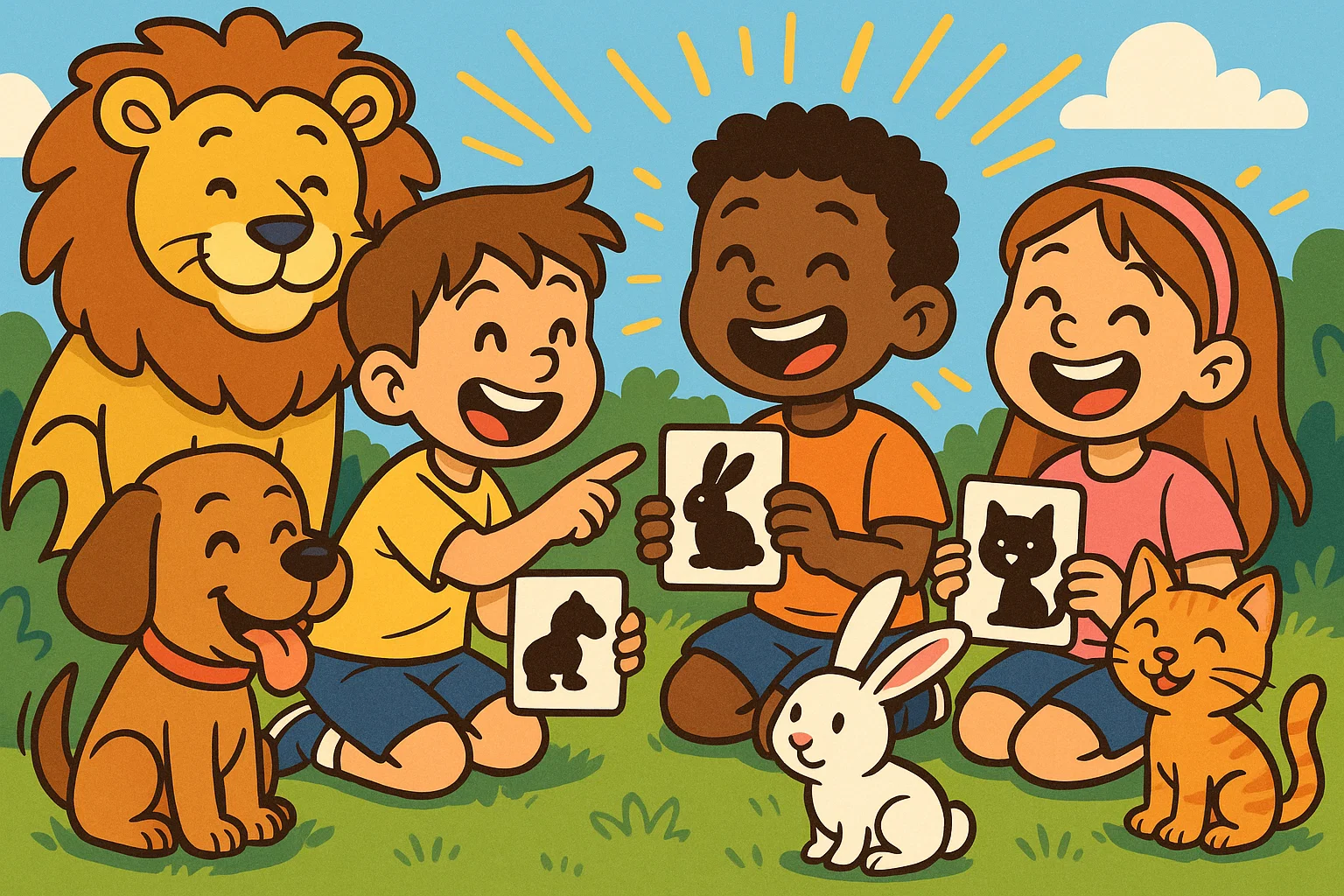
Children have a natural fascination with animals, making these riddles a big hit.
Farm animal
- I am black and white and give milk. I have a bell but can’t ring it. What am I? Answer: A cow.
- I have a wool coat and say “baaaa.” I am a sheep, but what am I called when I am a baby? Answer: A lamb.
- I have a big nose, love to roll in the mud, and you can find me on a farm. What am I? Answer: A pig.
- I have a red comb and a beak, but no hair on his head. I wake everyone up, but I am not an alarm clock. What am I? Answer: A rooster.
Wild animal
- I have a mane but no hair on his head. I roar to be heard. What am I? Answer: A lion.
- I live in the jungle, and I have a long trunk. I can be an elephant, but my first two letters are different. What are they? Answer: My first two letters are ‘E’ and ‘L’.
- I have a big mouth but never eat. My body is brown, but my tail is striped. What am I? Answer: A hippopotamus.
- I have stripes but am not a prisoner. I am a cat but live in the wild. What am I? Answer: A tiger.
Pet
- I have a tail and love to bark. My owner has daughters but no sons. How many dogs do they have? Answer: The riddle doesn’t actually mention dogs—it’s a trick question. The answer is that the family has one son (since all the daughters share the same brother).
- I have a mouth but never talk, a head but no hair on my head. I have a bed but never sleeps. I love to chase a red dot. What am I? Answer: A cat.
- I can pass the person, but I will never walk. I have four legs and love to be petted. What am I? Answer: A dog.
- I live in a small space, but I have no room. I have a shell but no eggs. What am I? Answer: A pet turtle.
Benefits for Kids
Engaging with riddles is about more than just fun. Research in cognitive development suggests that these simple games for kids are powerful tools for learning and development. They are a great way for kids to exercise their minds, much like a physical workout for the body.
Boosting memory and attention
Solving riddles requires holding clues in one’s mind, a process that strengthens working memory. It’s a mental juggling act where kids must remember all the pieces of information to arrive at the solution. This process helps them improve their ability to focus and concentrate on a task. For example, a riddle like “I am light as a feather, yet even the strongest person can’t hold me for more than a few minutes” requires the child to remember the two contradictory clues—”light as a feather” and “strongest person can’t hold me”—to deduce the answer.
Encouraging creative thinking
Riddles often rely on wordplay, metaphors, and lateral thinking. They teach children to look beyond the obvious. This is crucial for creative problem-solving skills. For instance, a riddle about cities with no buildings challenges a child to redefine what “city” means in this context, pushing them toward a more imaginative solution like a map. Studies of puzzle-based and logic games suggest that engaging in these types of challenges is associated with improvements in creativity, problem-solving, and cognitive flexibility.
Social and family bonding
Riddles are inherently social. They can be a shared activity that brings families and friends together. Trying to figure out a tough riddle as a team fosters communication, cooperation, and a healthy sense of competition. Sharing a laugh over a funny riddles for kids or celebrating a moment of success when someone figures out a hard one creates positive memories and strengthens relationships. It’s a simple, screen-free way to connect and spend quality time together.
How to Create Your Own Riddles
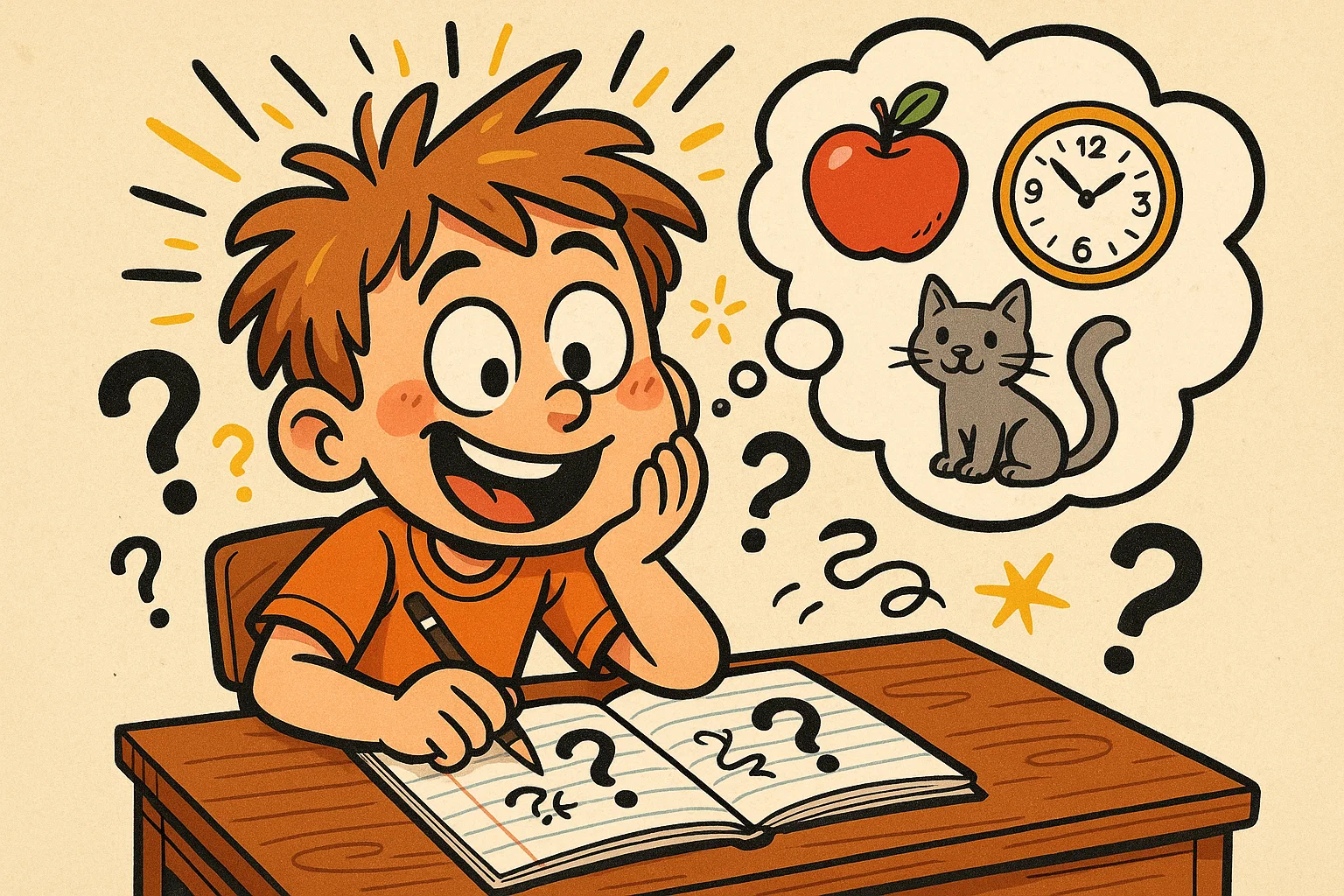
The ultimate way to get kids engaged is to empower them to create their own riddles. It’s a fun project that reinforces their learning and lets them put their newfound skills to the test. Here’s a simple guide.
Start with the answer
The easiest way to begin is by choosing the solution first. Pick an everyday object, like a ball, a book, or a chair. You want to choose something they’re familiar with.
Add clues step by step
Once you have the answer, brainstorm clues. Think about the object’s characteristics, functions, and appearance.
- What does it look like? (It is round)
- What does it do? (It bounces)
- What is it used for? (You can throw it and kick it)
- What makes it special? (It can be used in many games for kids)
The goal is to provide enough clues to make it solvable but not so many that the answer is obvious. You can use phrases like “I have,” “I am,” or “I can.”
Test your riddle on friends or family
Creating a riddle is an interactive process. Encourage your child to share their riddle with others. This provides valuable feedback and teaches them how to refine their clues to make the riddle more effective. It’s a wonderful opportunity for them to see their creative efforts bring joy to others.
Free Printable Riddles for 8 Year Olds
For a quick and easy solution, printable riddles with answers for kids are an excellent resource. You can print them out and use them for parties, classroom activities, or just to have on hand for a spontaneous riddle session.
Printable easy riddles
These are great for a beginner’s worksheet. They are designed to be fun and build confidence. You can even include a little box for them to draw the answer.
Printable tricky riddles
For a more challenging activity, print a page of harder brain teasers. You can make it a competition, offering a small prize for the first person to solve them all. This can be particularly useful for a small group of kids.
Printable holiday riddles
Themed riddle sheets are a fantastic way to celebrate holidays. You can have a sheet for Halloween with spooky riddles, a sheet for Christmas with festive questions, or a sheet for summer with beach-themed puzzles. This helps kids connect learning with celebration.
More Fun Brain Games for 8 Year Olds
If your child enjoys solving these riddles, they will likely love other types of brain games. These activities continue to foster the same critical thinking skills and problem-solving skills that riddles do.
Logic puzzles
Logic puzzles, like Sudoku or the classic river crossing riddle, are excellent for developing systematic reasoning. They teach kids how to break down a complex problem into smaller, more manageable steps. The key is to think methodically and eliminate possibilities, a skill that is valuable in all areas of life.
Word searches and crosswords
These classic games are a fun way to reinforce vocabulary and spelling. Word searches help with pattern recognition, while crosswords require a deeper understanding of word meanings and context. They are a gentle way to introduce language arts in a playful format.
Educational games online
Many websites and apps offer a wide variety of educational games. These can range from coding puzzles to memory games and math challenges. When used in moderation, they can be a highly engaging and interactive way for kids to continue their learning and development journey. Look for apps that offer a balance of challenge and reward to keep your child motivated.
